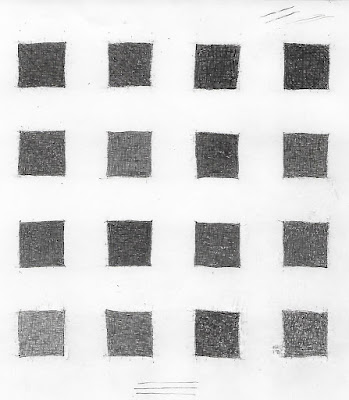 |
| The Elements of Drawing - Exercise 1 Ink on Paper 18cm x 15.75cm (7" x 6.25") |
I seem to be “drawn” to old art instruction books. John Ruskin (1819-1900) wrote "The Elements of Drawing" in 1856. It’s amazing to follow lessons written by a contemporary and friend of J. M. W. Turner (1775-1851).
I like that Ruskin is more interested in helping his readers to learn to love nature and appreciate great art than he is in teaching them to draw, but the book won’t be to everyone’s taste. The writing and overall tone is old fashioned and authoritarian.
 |
| One of Gillott's lithographic crowquills |
You draw boxes and fill them in with crossed lines “so completely and evenly that it shall look like a square patch of gray silk or cloth, cut out and laid on the white paper”.
If areas of the square are too light, you darken them by drawing more lines or dots. If areas of the square are too dark, you “use the edge of your penknife very lightly, and for some time, to wear it softly into an even tone”.
This is all more difficult than it sounds. The nib and the knife are both difficult to master. Every time you darken an area by adding more ink, the overall tone of the square gets darker. Every time you try to lighten the tone with the penknife, the paper gets rougher and becomes more unpredictable in how it takes ink. Eventually the paper becomes so rough that further improvement is impossible.
It is difficult to know whether you've successfully completed the exercise. Initially, I thought my efforts were relatively poor when compared with the example for the exercise.
 |
| The Elements of Drawing - Exercise 1 |
But the example is a dark square, which Ruskin acknowledges is easier to achieve than a lighter one. I flicked ahead to Exercise 3 in which you create a greyscale.
 |
| The Elements of Drawing - Exercise 3 |
Parts of this look rougher than my efforts, so I’m calling Exercise 1 done and I will reevaluate my progress when I try the greyscale in Exercise 3.




